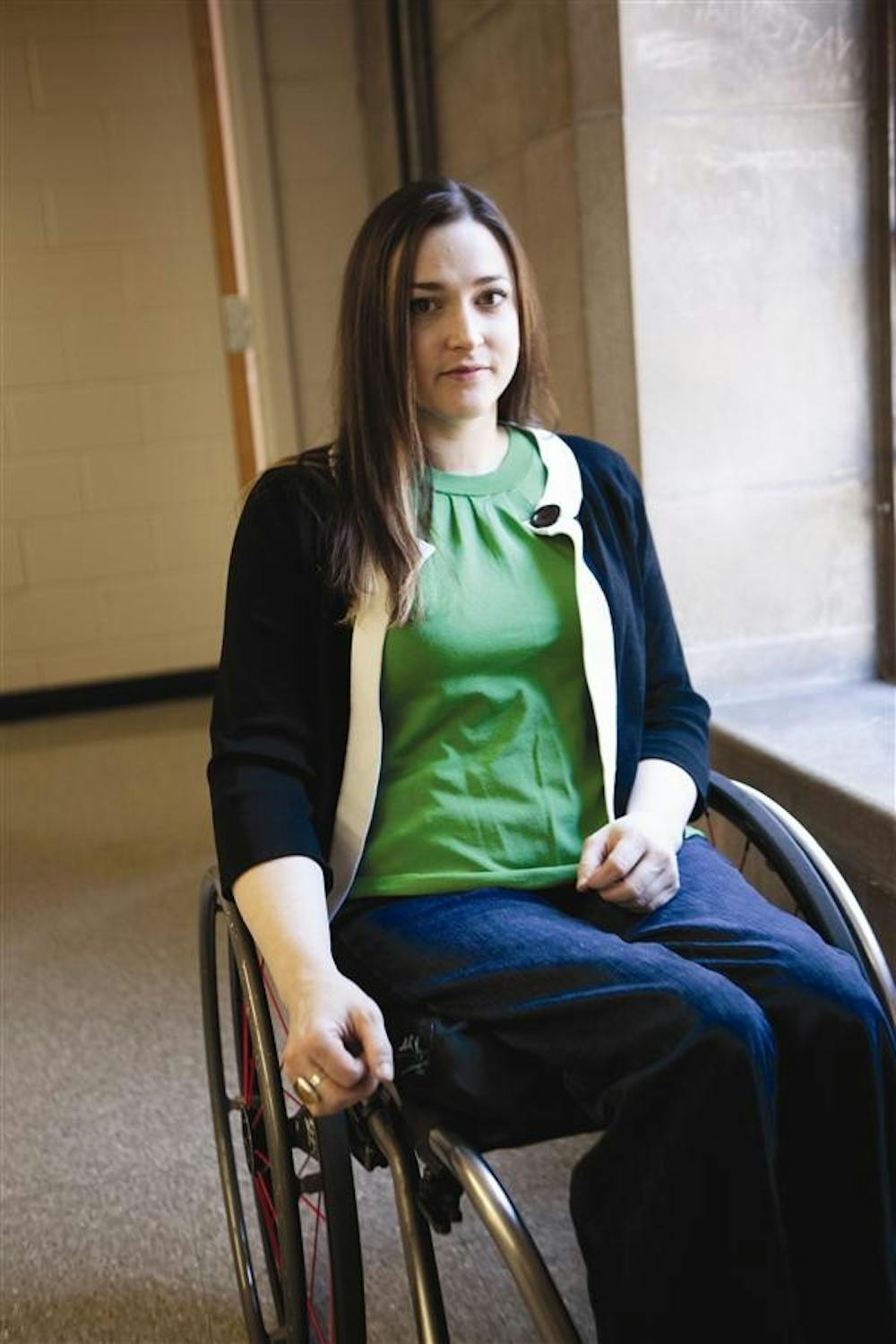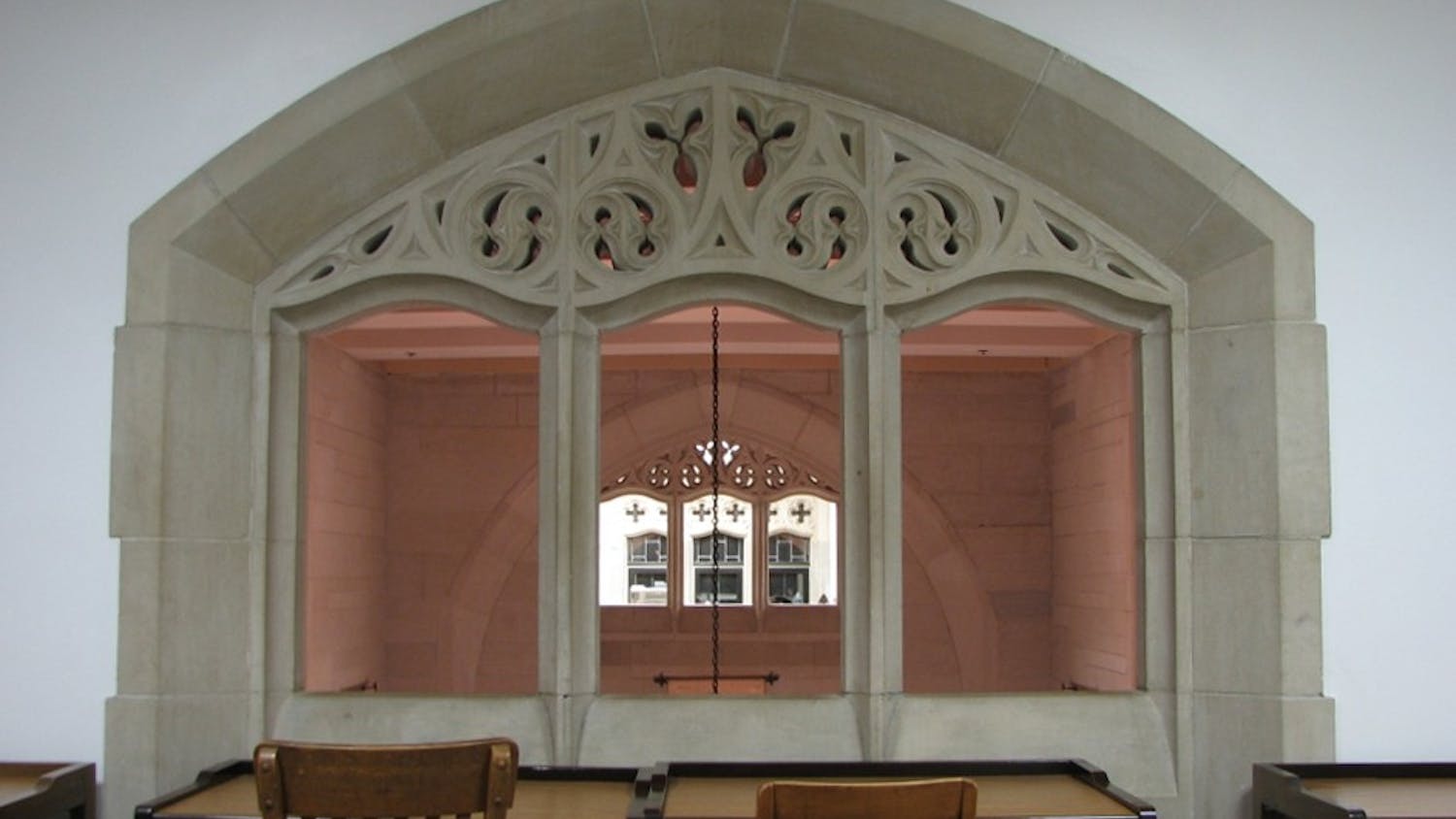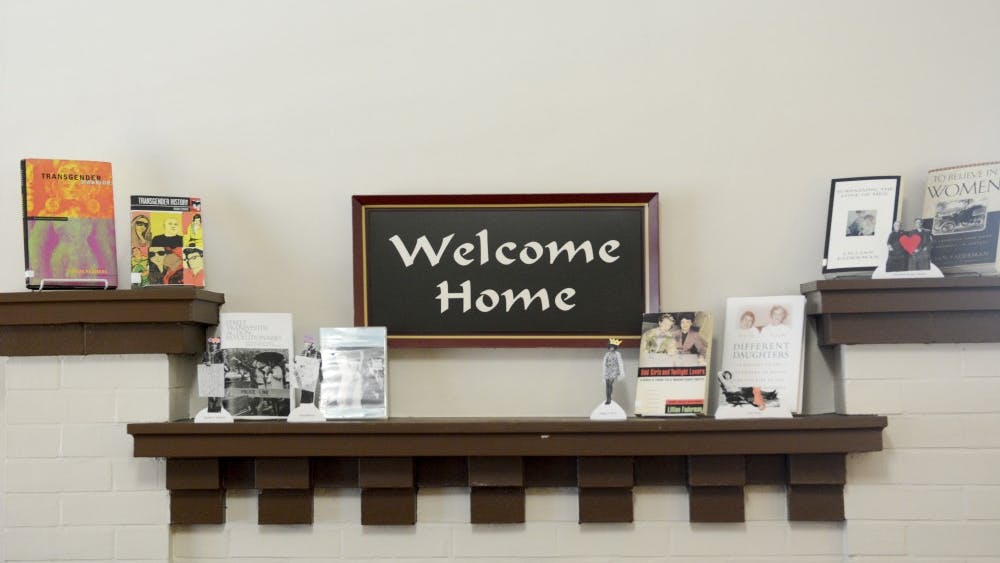Joannah Peterson pulls up to the curb in front of Goodbody Hall. A handicap tag hangs in her silver Honda Accord, but the reserved spaces are taken. She parks behind them illegally, along the curb. She’s already found six parking tickets tucked under her wiper this year, but she can argue her way out of another one.
This fall Friday morning, she’s running a little behind. She has office hours for an Asian history class and a few e-mails to send off.
She opens the car door, lifts out her wheelchair frame, attaches one wheel and then the next. After scooting herself onto the chair, she closes the car door and rolls up to the sloped entrance. She zig-zags along the ramp, lifting up her wheels slightly so she won’t get stuck in cracks. She reaches the big blue button with the image of a stick man in a wheelchair. Instead of pressing it, she opens the door herself and rolls inside.
The basement of Goodbody is stark white. It smells a little moldy. Sometimes Joannah calls it The Dungeon, sometimes The Belly of the Beast.
Inside, Joannah looks left. There’s a hallway and then a staircase. The East Asian Languages and Cultures department is on the second floor. There is no elevator. Thirty-five steps separate Joannah from her department.
She turns to the right and wheels silently down the hall and into room 003-6, the corner room that serves as her ground-level office.
LITTLE BASEMENT OFFICE
The first time you meet Joannah, it’s her huge brown eyes you notice, and the expressive way she laughs with them.
She doesn’t usually tell people this, she says, but she loves to pop little wheelies and crunch Coke cans under her wheels.
Some Friday nights, she and her friends visit Asian grocery stores and experiment with the ingredients. Or they play Apples to Apples, and turn it into a drinking game. Joannah’s best friend lives in Louisville, Ky. They’ve been friends since they were kids.
A car accident the summer before her freshman year of high school paralyzed Joannah. She can’t walk, but she has full use of her arms.
She picked a wheelchair that’s narrow and strong like those used in the wheelchair-rugby movie, “Murderball.” Joannah is not disabled because she uses a wheelchair, she says. Joannah gets around because she uses one.
She confesses to studying about 10 hours a day. As a Ph.D. student in the East Asian Languages and Cultures department, she’s both a student and a teacher. She writes papers about voyeurism — peeping through fences and blinds — in Japanese literature.
She doesn’t have free time to make sculptures, something she loves to do. Now, her creative releases are pumpkin carving and cake baking. This summer, she made a cake that looked like a platter of sushi with jellybean fish eggs and fruit-leather seaweed.
She wears her brown hair pulled back from her fair face. She rests her freckled arms on her still legs.
This fall Friday, three other people are already crammed in Joannah’s basement office, which also serves as a resource room for six Japanese assistant instructors. The room is crowded but the walls are not. On the big bulletin board, there’s a business card for Domo, a sushi restaurant.
Joannah is an assistant instructor for E-100, East Asia: An Introduction. Friday mornings, she talks with students in the office, and the department gives her the room to schedule meetings and print papers. There’s a phone to call upstairs if she needs something carried down.
Today, she has pulled her red spokes and rubber tires up close to the desk across from the door. She is frustrated. She has 15 minutes to send her thesis to a regional competition, and the computer won’t read the document, a huge PDF file that includes full-color illustrations. It’s about female peeping in the Japanese novel, “The Tale of Genji.” The old Dell can’t handle it.
The graduate secretary of the department enters the room and Joannah asks her to save the file on a computer upstairs. Joannah hands her a green flash drive shaped like edamame, a soy bean pod served in sushi bars. The secretary hikes the thesis in the bean pod upstairs.
Joannah has never seen her printed thesis, which she completed last spring. She says it’s just a big heavy book. She could have someone carry it downstairs, she says, but perhaps she’d notice a mistake.
Although Joannah’s adviser calls her one of the brightest scholars in the department, she can’t drop by for office hours or use the computer lab upstairs.
Joannah is one of about 10 IU students in a wheelchair, according to Disability Services for Students. These students struggle through buildings with inaccessible areas, stairs to get to elevators, and narrow passageways.
DSS addresses issues as they arise for each student, although there are only four professional DSS staff members. In 2007, IU’s disability services had the worst student-to-staff ratio in the Big Ten. For even the most focused small staff, an elevator is a $100,000 beast of a construction project to initiate.
DSS director Martha Jacques Engstrom pushed for larger restrooms in the basement of Goodbody. Joannah was grateful, but soon realized the bathroom — not an elevator — was the University’s contribution to her case.
“Martha fought tooth and nail to get that bathroom in,” Joannah says. “But the bathroom reminds me of how long I’ve been in that building without an elevator.”
WHAT’S UP THERE
The walls on the second floor are bright yellow. Japanese tapestry hangs along the staircase. At the top of the second flight is a shelf of free books and magazines. A sign invites, “Please help yourself.”
The department chair sometimes brings his famous oatmeal chocolate chip cookies to share.
Down the hallway, the graduate lounge is quiet. There are Chinese and Japanese characters on the blackboard, remnants of earlier meal-time talks. There are plants in the corner and a table in the middle, covered in crumbs. The refrigerator in the corner holds someone’s Slimfast touching someone’s salad.
There’s a reading room full of theses bound in hardcover, including Joannah’s. At the end of the hall is a computer lab.
Her adviser’s office is in the middle.
“It’s a real loss to her not to be able to come into my office,” Edith Sarra, director of graduate studies, says. “She should be able to see what my research collection looks like. This is where the scholars of her field are.”
Joannah wants to see that shelf of free books, the computer lab, and Sarra’s office. “I’ve been thinking about having a friend bring me up there,” she says. “Maybe just carry me.”
UNIVERSITIES ARE MADE OF INDIVIDUALS
Joannah doesn’t dwell on what she’s missing.
“I’ve got too much to do to wait for other people to fix things for me,” she says. “I have too many places to go. Maybe that’s why I’m not a good activist. My focus is on being a good student.”
Joannah has been asking for access since she arrived five years ago. She was admitted into the graduate department in 2004. In 2006, she traveled in Japan through a Stanford program. When she returned to IU in 2007, she pushed for recognition. She went on a local radio show. She challenged administrators and demanded action.
As a state institution, IU must follow the Americans with Disabilities Act, which lays out codes for new buildings. The guidelines apply to structures built after 1990. Old buildings are only required to add accessible features if a renovation takes place.
In 2007, Joannah met with Provost Karen Hanson. Hanson remembers meeting with Joannah, although she didn’t share good news.
No one wants to deprive Joannah of access to her department, Hanson says. But the buildings are old. Goodbody was built in 1936. It is not high on the construction priority list.
A university architect says it’s about money, of course. It’s expensive to conduct a survey to see if an elevator could fit inside Goodbody. There’s also the possibility of a chair lift, but that would also require an overall accessibility survey.
Joannah is pinning her hopes on 2012. That would mean access eight years after Joannah’s arrival. By then, she hopes to have finished her three-year fellowship at IU, traveled and researched in Japan, then returned to Bloomington to finish her dissertation. There’s talk of construction: a new international building behind the Herman B Wells Library. EALC would move there, hopefully.
Hanson says that in this economy, it’s a long shot to hope for a 2012 completion date.
Joannah lives in a world where frustration is part of life. She knows the problems with asking for an elevator, she’s heard the reasons. She also knows that Kirkwood Hall, one of the campus’ older buildings, just finished its installation of an elevator.
It is painted a gold color and its lights cast a soft glow.
“I think they could have put one in here and one in there for the price of having it gilded,” she says. “It’s like if you needed five staircases, and instead you put one marble one in.”
THE SAMURAI TEACHER
At 2:15 p.m., it’s time for Joannah to leave the little office and teach her second discussion section.
She drives to the Ballantine Hall parking garage using hand controls made of long poles attached to her car’s pedals. The handicapped parking spots on the ground level annoy Joannah. They lead to stairs to get into the building, meaning there is no accessible entrance there.
She drives past those spots and onto the first level. After parking in a handicap spot, she gets out of her car and slips onto her wheelchair. A ramp guides her way. Inside, she has a key to the elevator. She takes it up two floors and enters the classroom on the third floor.
Joannah teaches with a calm command of her students. She wheels across the front of the classroom. When she asks questions, students are quick to respond. Today, she’s leading a discussion about Japanese history: about collectivism and unity, individuals and struggle. Joannah asks the students to write an essay about samurai warriors. “Why did we describe them as outsiders?”
ACROSS THE OCEAN
Joannah traveled throughout Japan for the first time from 2000 to 2002. The prestigious Japan Exchange and Teaching Programme had never accommodated someone in a wheelchair before.
The Japanese students who met Joannah were fascinated by her. She came at the end of one of Japan’s most successful TV shows, “Beautiful Life,” starring a mega-idol who falls in love with a woman in a wheelchair, also played by a Japanese superstar.
Japan’s NHK news covered Joannah in an hour-long TV special, and she was the focus of a Japan Times article titled, “Challenging the stereotype: Breaking down people’s mental barriers.”
Joannah is a teacher, a cake-baker, a scholar, and a woman who laughs when she pops cola cans with her wheelchair. She is, above all, a tired activist and an excellent student.
If Joannah could roll onto the second floor of Goodbody, she could brush aside the crumbs on the graduate lounge table, set her bound thesis down, and pull her wheels up close to the table. She could flip to the back of her book, where colored pictures jump from the page.
The final illustration in Joannah’s thesis—she hasn’t seen it in print— shows a large room divided. On one side of the room, two men play Go, a game with black and white pieces.
On the smaller side of the room, two women in bright flowing robes look through a crack in the door. They move aside a veil of fabric and peer in.
Steps in her way
One student’s struggle to access the second floor of Goodbody Hall.

Get stories like this in your inbox
Subscribe





